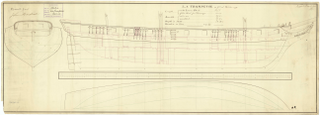Related Research Articles
Jean Bart may refer to one of the following ships of the French Navy or privateers named in honour of Jean Bart, a French naval commander and privateer.

HMS Martin was a 16-gun sloop of the Royal Navy. She served at the Battle of Camperdown in 1797 and captured two privateers before she disappeared in 1800.

HMS Trompeuse was the French privateer Mercure, captured in 1799. She foundered in the English Channel in 1800.

HMS Cruizer was a Royal Navy Cruizer-class brig-sloop built by Stephen Teague of Ipswich and launched in 1797. She was the first ship of the class, but there was a gap of 5 years between her launch and the ordering of the next batch in October 1803; by 1815 a total of 105 other vessels had been ordered to her design. She had an eventful wartime career, mostly in the North Sea, English Channel and the Baltic, and captured some 15 privateers and warships, and many merchant vessels. She also participated in several actions. She was laid up in 1813 and the Commissioners of the Navy sold her for breaking in 1819.
During the French Revolutionary and Napoleonic Wars, British vessels captured at least 12 French warships and privateers named Espoir, which means “Hope” in French. In only one case was there mention of an exchange of fire or casualties. In general, the privateers tried to escape, and failing that surrendered.
HMS Anacreon was a French privateer launched in 1798 that the Royal Navy captured in 1799 and took into service. She had a brief career in which she took some minor prizes and engaged two enemy vessels in an inconclusive action. She was sold in December 1802.

HMS Kangaroo was British Royal Navy 18-gun brig-sloop of the Diligence class, launched in 1795 at Deptford, England. She served in Home Waters and the Mediterranean Sea until she was sold in 1802.

The French frigate Aigle was launched in 1780 as a privateer. The French Navy purchased her in 1782, but the British captured her that same year and took her into the Royal Navy as the 38-gun fifth rate HMS Aigle. During the French Revolutionary Wars she served primarily in the Mediterranean, where she was wrecked in 1798.

HMS Hound was a brig-sloop of the Royal Navy. She had a short history. After her launch in 1796 she captured two privateers and destroyed a third before she was lost in 1800.
Two vessels named His Majesty's hired armed lugger Sandwich served the British Royal Navy, one during the French Revolutionary Wars, and the other during the Napoleonic Wars.
His Majesty's Hired armed cutter Sandwich served the Royal Navy from 23 May 1798 until the French frigate Créole captured her on 14 June 1799. She then served in the French Navy until the Royal Navy recaptured her on 15 October 1803. The Navy purchased her in 1804 and she served for some months in 1805 as HMS Sandwich before she was sold in Jamaica. During this period she captured three small French privateers in two days.
Numerous vessels have been named Vautour :
Numerous French privateers have borne the name Vengeur ("Avenger"):
The British Royal Navy captured at least four French privateers named Adolphe during the period of the French Revolutionary and Napoleonic Wars:
Courageaux was commissioned in Bordeaux in 1798. She made two cruises as a privateer before HMS Alcmene captured her in 1799. The British Royal Navy took her into service as HMS Lutine. She had a brief operational life in the Royal Navy, serving primarily as a prison ship. At the end of the French Revolutionary Wars in 1802 the Royal Navy sold her in the Mediterranean.
The Royal Navy purchased HMS Barracouta on the stocks in 1782. After she had served for almost ten years patrolling against smugglers, the Navy sold her in 1792. She became the privateer Thought, which had a successful cruize, capturing several prizes including a French privateer, but then was herself captured in September 1793. She served the French Navy under the names Pensée, Montagne, Pensée, and Vedette, until the British recaptured her in 1800 and renamed her HMS Vidette. The Royal Navy sold her in 1802.
HMS Stag was a 32-gun fifth-rate frigate built for the Royal Navy. She was ordered in 1790 and work began in March 1792 at Chatham Docks. Completed in August 1794, Stag spent much of her service in home waters, where she worked to protect British shipping from French privateers. In an action on 22 August 1795, Stag engaged, and forced the surrender of, the Dutch frigate Alliante, and took part in the chase that ended with the capture of Bonne Citoyenne by HMS Phaeton on 10 March 1796.
HMS Growler was a Courser-class gun-brig built for the British Royal Navy at Northfleet and launched in 1797 as GB No. 26; she was renamed Growler on 7 August the same year.
Mentor was launched in 1792 at Wemyss. With the out break of war with France in early 1793, the Royal Navy needed smaller vessels to protect convoys from privateers. The Navy employed Mentor as a hired armed vessel, releasing her from her contract at the end of 1801 after the signing of the Treaty of Amiens. She then returned to mercantile service, sailing first to Hamburg and then Oporto. She became a coaster on England's east coast, or a Baltic trader. She was last listed in 1832.
References
- Demerliac, Alain (1999). La Marine de la Révolution: Nomenclature des Navires Français de 1792 A 1799 (in French). Éditions Ancre. ISBN 2-906381-24-1.
- Winfield, Rif; Roberts, Stephen S. (2015). French Warships in the Age of Sail 1786–1861: Design Construction, Careers and Fates. Seaforth Publishing. ISBN 978-1-84832-204-2.